Behind The Scenes At The Most Ambitious Man Build In Burning Man History
Update: The Man project has been delayed several days and as of Thursday morning, Sept. 1, was still not rotating. Below is a comment from Burning Man spokesperson Jim Graham:
“When the Man was mounted to the drive mechanism on Tuesday, we encountered more torque than expected, resulting in a couple of connection bolts being sheared. We ordered stronger bolts, but after being replaced, we had a failure of the U-joint in the transmission system. Burning Man organizers made the decision to rotate the Man to an upright position and lock it in place to allow participants access to Man pavilion beginning Wednesday morning.”
Original post:
Deep inside a dark tractor trailer in the middle of North America’s most remote piece of desert earlier this month, a doomed Man lay strapped down, waiting to be taken outside, mounted and spun around for all to see, and eventually be burned in front of hordes of screaming, ecstatic people.
Fear not: We haven’t returned to the days of torturing witches and heretics, at least not in the United States. This is the Man, the centerpiece and namesake of this week’s Burning Man arts festival in Nevada’s Black Rock Desert, where he will be a true sight to behold, a 43-feet-tall, 20,000-pound modern-day interpretation of Leonardo da Vinci’s Vitruvian Man, suspended 50 feet in the air, rotating 360 degrees perpendicular to the ground, all thanks to a whole lot of manual labor.
In short, a very impressive feat of building and engineering in a desert location where there is no power, no lighting, no water, no nothing, except during Burning Man when 70,000 people from all corners of the planet will flock here for a week to create one of the most vibrant urban environments on Earth—Black Rock City—and then, not long after the Man is burned to the ground, disappear with nary a trace.
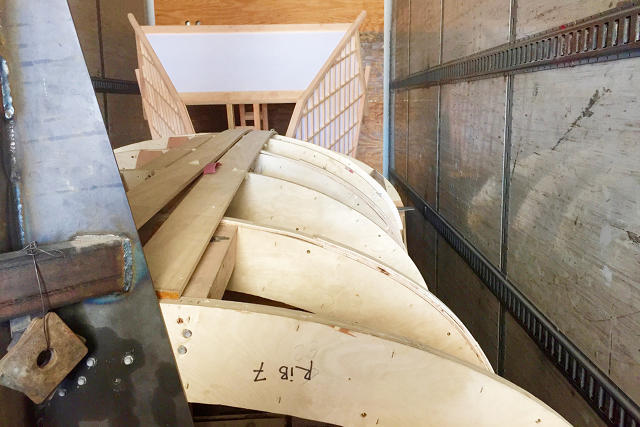
In mid-August, though, with fewer than 500 people on the playa—as the Black Rock Desert is known—Andrew Johnstone looked at the Man jammed in the back of that truck and, deadpan, summed up precisely what was going on.
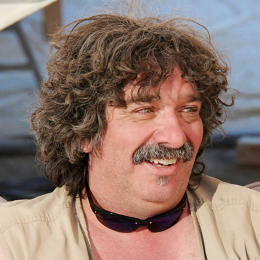
“He’s like the star of the show,” Johnstone, the lead designer on the Man project told me, “on the back lot, in his trailer.”
Before we get all into engineering concepts and counterweights and the vagaries of building a giant rotating contraption high in the air in the brutal, unforgiving desert for the entertainment of 70,000 Burning Man attendees, we have to travel to Florence, Italy, where our story begins.
Last fall, fresh off his second year as the Man’s chief designer, Johnstone, a short, jovial, 54-year-old professional artist with a headful of curly hair, a thick mustache, and a delightful Scottish accent, was vacationing with his family in Florence when word came from on high—Burning Man founder Larry Harvey—that the theme for the 2016 event was to be Da Vinci’s Workshop.
Every year, Burning Man, which turned 30 this year, has a theme, which is intended as somewhat of a guidepost for artists to use as inspiration for their projects. Some do, many don’t. Some years, like 2013’s Cargo Cult, it resonates. Other years, like 2012’s Fertility 2.0, perhaps not as much.
Da Vinci’s Workshop, though, seemed full of potential from the get-go. After all, Da Vinci was, to quote Wikipedia, a “polymath whose areas of interest included invention, painting, sculpting, architecture, science, music, mathematics, engineering, literature, anatomy, geology, astronomy, botany, writing, history, and cartography,” many of which are foundational elements of Burning Man and its creative community of artists, musicians, and engineers.
Johnstone has no doubts: “I think if Da Vinci was around, he’d be a Burner. He’d have his own camp, and he’d be hassling Burning Man for” an artist’s grant.
When the theme was announced, it was explained in terms that, hopefully, the community would understand, or at least relate to, given how many Burners—as attendees are known—come from San Francisco and Silicon Valley.
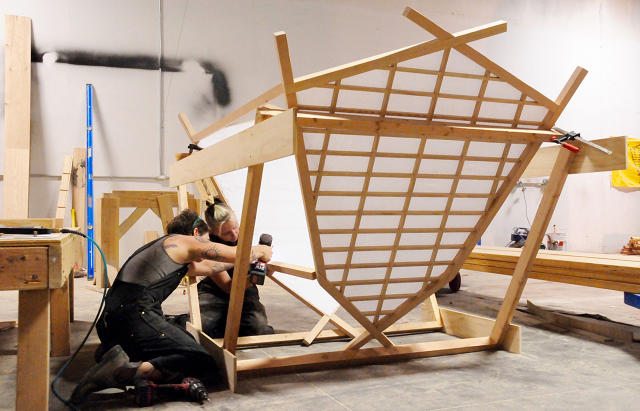
“Our story will focus on the republic of Florence, for it was here, in a city-state of about the same size and population as Black Rock City, that humanist ideals, a rediscovery of science, and funding from a newly moneyed class of entrepreneurs fueled a revolutionary cultural movement that redefined Western civilization,” the Burning Man organization wrote in announcing the 2016 theme. “Five centuries later, we will attempt to recreate this potent social alchemy by combining Burning Man art, maker culture, and creative philanthropy to make Black Rock City the epicenter of a new renaissance.”
Sitting in a large communal space at The Gate 510, the art, tech, and maker space in San Leandro, California, where the Man and many of its related components were constructed, Johnstone recalled being in Florence and finding out that Harvey had settled on the Da Vinci theme. Though the painter of the Mona Lisa was from Florence, it was pure coincidence that Johnstone was there.
“The trip [instantly] turned from tourism to research,” Johnstone remembered. “All of a sudden, I wasn’t just looking at the architecture, I was trying to download it.”
Over Burning Man’s 30 previous years, the Man itself has taken many different forms. More precisely, the base on which the Man is built has often morphed, while the Man himself has had only two or three main flavors. In its earliest years in the desert—the event began on San Francisco’s Baker Beach in 1986, and moved to the playa in 1990—the Man was built directly on the ground. From 1996 to 2000, he was mounted atop piles of hay bales.
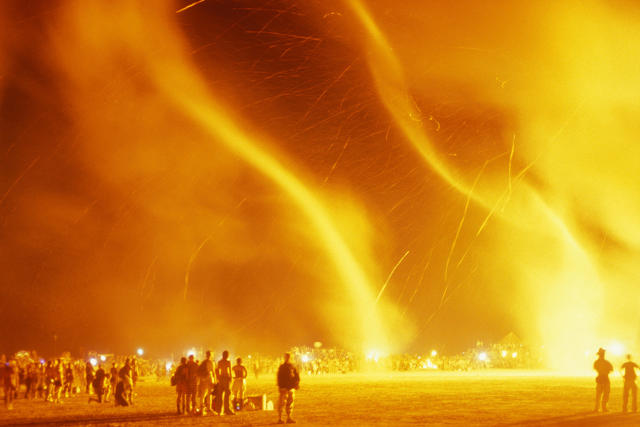
The modern Burning Man era began in 2001 when the Man was erected on top of a 30-foot-tall wooden tower. The burn that year was monumental, resulting in what have ever since been known to Burning Man veterans as “ancestors,” gorgeous fire-spawned dust devils that spin off the conflagration one after another and that are said to be the spiritual descendents of the Paiute Indians that once populated the area around the Black Rock Desert.
For many years, the Man was designed by Rod Garrett, who was also responsible for creating Burning Man’s city plan. Garrett, who died was a mentor to Johnstone, died in 2011.
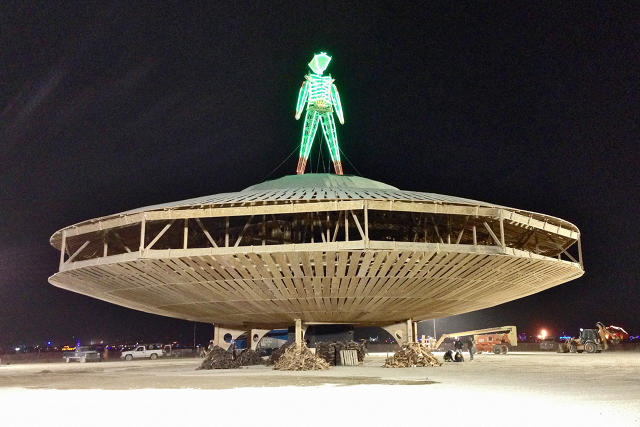
Suffice it to say that at an event where the bar is raised year after year on the scope and scale of art projects, the Man base has been no exception. While the Man himself has almost always been 40 feet tall, no previous year better exemplifies that trend than 2013, when the Man stood proud atop a massive, 55-foot-tall, 117-foot wide, classic 1950s sci-fi flying saucer. Well, except maybe 2014’s Man, Johnstone’s second as lead designer, which for the first time since 1995 stood directly on the playa. Whereas every previous Man had essentially been a skinny, skinless skeleton, 2014’s was 105 feet tall, and appeared thicker, and to be wearing clothes. He looked like he’d grown up.
By that measure, last year’s Man project was actually somewhat tame. Although the effigy itself was 60 feet tall, it was mounted on a large, wide (and just 9 foot tall) maze, meaning his head was nearly 40 feet lower than in 2014.
Clearly, it was time to step it up.
Harvey’s initial idea for 2016 was inspired by Da Vinci’s famous Vitruvian Man, which “depicts a man in two superimposed positions with his arms and legs apart and inscribed in a circle and square.”
The idea is audacious, yet fairly simple: Groups of burners will manually turn a giant wheel at ground level inside the Man’s base. That, in turn, will rotate a set of complex gears which will ultimately rotate the Man, framed by a giant wooden circle and suspended 50 feet in the air.
Although the Man will appear to be quite similar to Johnstone’s two previous designs, this year’s will be a “little beefier,” said Jason Wilkinson, a lead builder on the project. “We steroided him out” because the design called for a stronger Man.
It was a “flippy Man, the idea of him cartwheeling,” Johnstone recalled. “It took [Harvey] four or five seconds to utter, but it’s taken the better part of a year to figure out how to engineer and build it.”
Being in Florence afforded Johnstone up-close access to the Da Vinci Museum, which in addition to things like his diving suits and tanks that may well have been hundreds of years ahead of his time, also houses a number of miniature models based Da Vinci’s writings, known as the codexes.
“It was very, very useful,” Johnstone told me while we sat on dusty couches during a break from building the Man base on an extremely hot Black Rock Desert day earlier this month. “Seeing something in 2D in red chalk is one thing, but to see it physically, built out of wood, is a different experience. It gets your gears going and all of a sudden an idea presents itself.”
Da Vinci himself had come up with all manner of designs for mechanical lifting using gear systems, and it’s clear from comparing photos from the museum in Florence that Johnstone incorporated the same look and feel in the giant wheel-like gears that will rotate the Man.
The base on which the Man will be mounted is huge, and it seems extremely complex. But in a way it’s fairly simple—not least because there are no electronics involved. Everything is people-powered.
As groups of Burners turn the ground-level wheel underneath the Man, the wheel spins a long thin rod, atop which is a second wheel adorned with vertical gear teeth. As those teeth spin, they rotate a vertical gear that, long story short, turns the Man itself.
Looking at the plans for the project, it all seems very rigid and engineered. But Burners will actually see the artistic version of this, with Florentine-style painting on the outside walls of the structure, as well as a frieze on the ceiling of the base building that depicts a series of images of the Man interacting with various Da Vinci inventions.
“If I can be so bold, I wanted to do it in a way that would make him proud,” Johnstone said. “I hope he’d be very honored by what we’re doing. I think he’d be absolutely delighted by the cleverness, this mixing of art and engineering.”
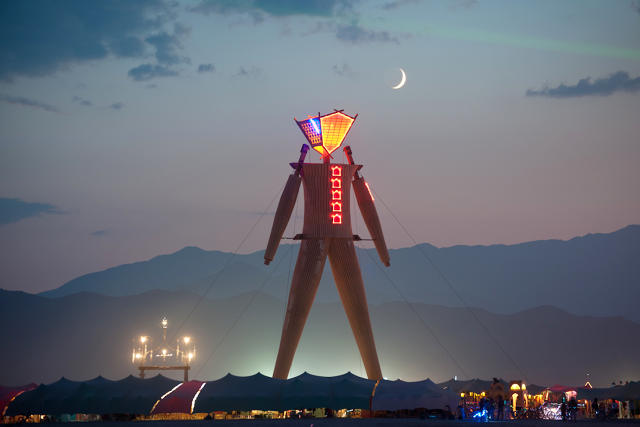
Time To Build
Designing this Vitruvian Man is one thing, building it is something else altogether.
For that, Johnstone turned to Joe Schwan, otherwise known at Burning Man as Joe the Builder.
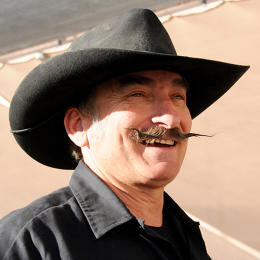
Schwan has been the lead builder on the Man project since 2009, and over the years has led a number of different Man build teams. Like many things in the Burning Man world, there are politics involved. In 2014, the longtime Man Krewe was suddenly disbanded and largely replaced with newcomers, a decision that still rankles people on or close to the previous team.
Nevertheless, Schwan is still in charge and by all appearances inspires loyalty from his current crew of between two and three dozen, some of whom wear “Joe the Builder Fan Club” patches featuring the Man’s head, Schwan’s signature black Stetson and handlebar mustache, and a clown nose.
Sitting in the small shed on the build site that is his office, Schwan recalled Johnstone coming to him with the concept for the Vitruvian Man and asking if it could be built.
“I look at it for a few minutes, and in those few minutes, I have to be able to build in a couple of different ways in order to say yes,” he told me. “So that’s what I did. I sat and looked at it, because…working out here [in the desert, far from civilization] is not like working in town where you have everything at your disposal.”
To be sure, there are other factors at work beyond the accessibility of tools and parts. The Black Rock Desert is one of the harshest environments in the world, with weather that can veer in minutes from blazing hot and calm to hurricane-like wind conditions, along with rain, thunder, and bitter cold.
Given the thousands of pounds of structure and Man the base has to support, along with the extreme wind dynamics and the fact that the Man will be rotating 360 degrees perpendicular to the ground, it’s no wonder that any builder, let alone the man constructing the event’s centerpiece, would want to have a backup plan in case his initial idea didn’t pan out.
Indeed, it might not occur to anyone else, but to Joe the Builder, the concept was clear: Treat the ring encricling the Man as the project’s foundation, and then build the rest of the building to support that foundation and the accompanying forces and opposing forces.
“It is a challenge, you have no idea,” Schwan said. “Because the forces are moving, and he is not like a bicycle wheel. He is top heavy, so when his force comes down, he wants to move all on his own.”
In ideal conditions, he would have used electronic or electromagnetic brakes to keep the Man’s rotation to a manageable speed, but the playa doesn’t allow for that. That meant relying on a friction brake that will limit the Man to no more than 2 RPM, no matter if the groups of people spinning the wheel below try to go faster.
As we spoke, the event was still several weeks from opening its gates, and not only was the Man still strapped down inside the truck, but the building of the base had only just begun.
That meant that Schwan still had to be prepared with modifications in case his plan wasn’t up to the realities of bringing Johnstone’s design to life in the Black Rock Desert.
“I’ve already got them designed,” he said, “but they’re in my head. I didn’t want to put them on paper, because that means I admit they’re real.”
Making modifications doesn’t only happen on the playa. Schwan said that not long after beginning the construction process, he realized that his original design couldn’t handle the load or the forces to which it would be subjected.
“I realized we needed a bigger building,” he said, “so we expanded the size of the building, which nobody would complain about because it’s just more firewood. But we needed it for the structure to make it safe.”
More firewood indeed. One would think that that would just contribute to a bigger fire and more happy Burners. But it’s also possible that the result would be that the Man takes longer to fall.
Ideally, explained Dimitri Timohovich, one-half of the husband-and-wife team that has been in since 2001, the Man falls in 20 or 30 minutes. But in both 2014 and 2015, perhaps thanks to Johnstone’s beefier Man design, it took well over an hour, leading to a certain amount of frustration on the part of spectators, emergency services workers, volunteers, and others who had to wait.
The problem is exacerbated by the fact that the Man has to be built to exacting standards.
“Because the Man is a public structure for the time the event is open, it has to comply to building codes,” Timohovich said. “Then we have to come in and burn down something that’s not supposed to burn.”
The build crew is taking certain steps to try to ensure a speedier burn this year, including fastening Duraflame logs throughout the Man’s body and utilizing as much non-fire-retardant wood as possible.
Still, Johnstone shrugs when asked about whether or not the Man will fall quickly, noting that the design has to withstand winds of up to 90 miles an hour.
“There’s a pyro crew and that’s their problem,” Johnstone said. “We hand it over to the pyro crew and they have to figure out how to burn it.”

Early Burn
Sometimes, though, the Man burns not just faster than anyone would want, but earlier.
In what to this day is arguably the most famous moment in Burning Man history, an attendee man took it upon himself to set the Man ablaze on the first night of the 2007 event.
Using a middle-of-the-night lunar eclipse as a diversion, he climbed the Man, set it on fire and ran, only to be quickly captured, arrested, and subsequently convicted of a crime.
But before anyone could stop the fire, the Man was engulfed, ultimately charred far beyond salvation.
While it usually takes weeks to build and construct each year’s Man, that episode in 2007 was a testament to the skills and commitment of the Burning Man community.
“The build crew was there, and said, We know what to do, the lumber’s already ordered and on its way,” Johnstone recalled. “That became a teachable moment—a crisis, and not only a crisis, but a crisis in an impossible environment. But it was a good example of what to do when things get bad. You don’t throw your hands up and quit. You order more lumber and get to work.”
The crew finished the new Man in 30 hours and the official burn went off exactly as planned.
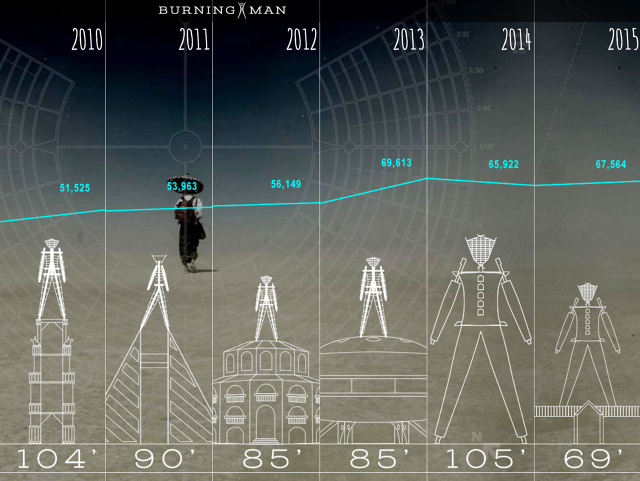
Always A Prototype
Burning Man is unlike almost any other festival. While there is some infrastructure built by the Burning Man Organization—the Center Camp cafe and the on-playa headquarters for a number of volunteer departments—almost everything else is built by the event’s participants themselves.
The Man, of course, is also built by the Org. But it has a completely different base every year, and so, as Johnstone put it, the project is “always a prototype.”
Essentially that means that every year, the build team has to figure out where the weak points in the design are, and solve as they go. It always seems to work, because it has to. But there are certainly moments when doubts creep in. This year is no exception.
“It’s going to be a relief when that thing starts turning,” Johnstone said. “But I have no doubt that it will.”
Susan Karlin contributed to this article.
Note: The author is a longtime Burning Man volunteer.
The 2012 Man burns as huge balls of fire erupt around it.
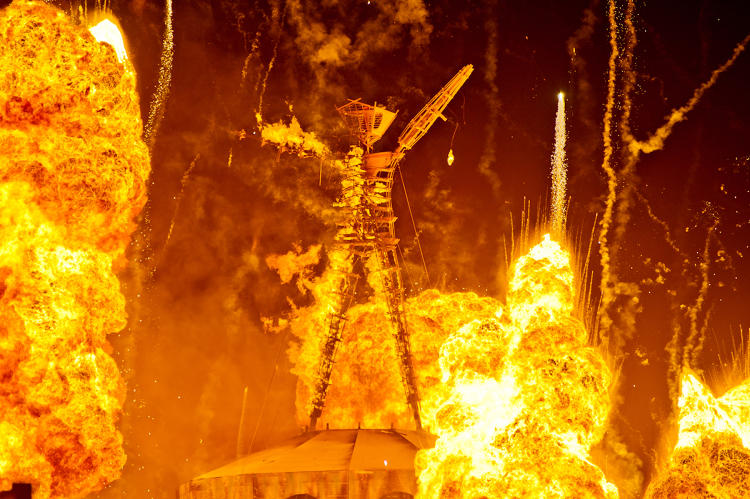
A blueprint showing the 2016 Man base.
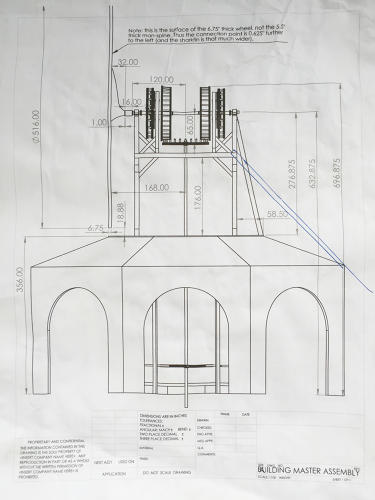
A blueprint showing the 2016 Man design.
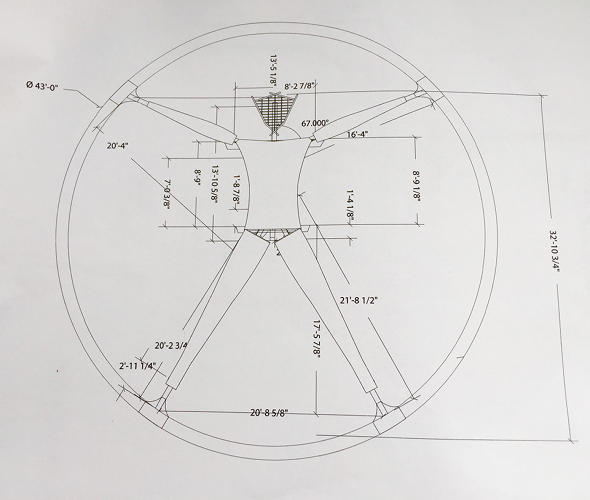
Flag designed by Andrew Johnstone depicting the Man’s head and Leonardo Da Vinci’s face to celebrate the 2016 theme of “Da Vinci’s Workshop.”

A sign at the Man build site in Black Rock City.

The 2016 Man was built at The Gate 510 in San Leandro, California, before being trucked to the Black Rock Desert, where it, and the Man base, are completed.

A hard hat adorned with years of stickers, including a Department of Public Works logo.

The Man’s lead designer, Andrew Johnstone, talking to the build team in Black Rock City, Nevada, home of Burning Man.

Leonardo Da Vinci was known for his design of complex gears. Those inspired the gears that will be used to rotate the 2016 “Turning Man.”
‘ src=”http://a.fastcompany.net/multisite_files/fastcompany/imagecache/slideshow_large/slideshow/2016/08/3063138-slide-s-11-burning-man-over-the-years-dt.jpg”>
The 2014 Man, standing amidst the Souk, a collection of art projects and interactive installations.

The 2013 man, standing atop the “flying saucer” during the day.
‘ src=”http://b.fastcompany.net/multisite_files/fastcompany/imagecache/slideshow_large/slideshow/2016/08/3063138-slide-s-7-burning-man-over-the-years-dt.jpg”>
The 2012 Man falls to the ground as it is overcome by fire.

Fast Company , Read Full Story
(133)














